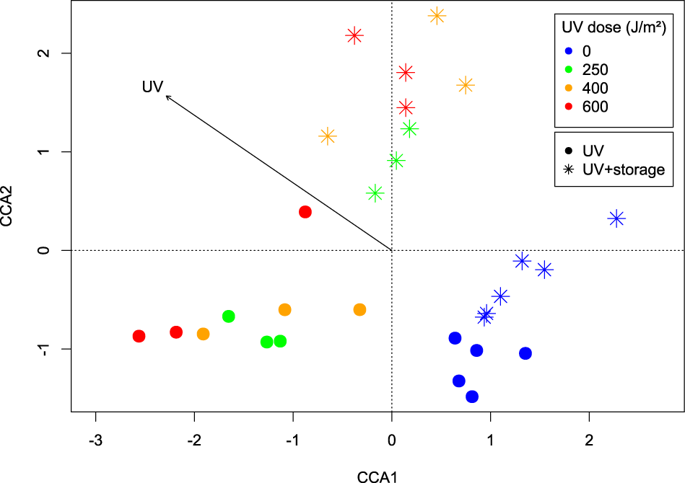npj Clean Water ( IF 11.4 ) Pub Date : 2020-03-19 , DOI: 10.1038/s41545-020-0057-7 Kristjan Pullerits , Jon Ahlinder , Linda Holmer , Emelie Salomonsson , Caroline Öhrman , Karin Jacobsson , Rikard Dryselius , Mats Forsman , Catherine J. Paul , Peter Rådström

|
Water in a full-scale drinking water treatment plant was irradiated with ultraviolet (UV) doses of 250, 400, and 600 J/m2, and the effect on bacterial communities investigated using 16s rRNA gene amplicon sequencing, heterotrophic plate counts (HPCs), coliform, and Escherichia coli counts. The bacteria in the irradiated water were also analyzed following storage for 6 days at 7 °C, to approximate the conditions in the distribution system. The log10 reduction of HPCs at 400 J/m2 was 0.43 ± 0.12. Phylogenetic examination, including DESeq2 analysis, showed that Actinobacteria was more resistant to UV irradiation, whereas Bacteroidetes was sensitive to UV. Phylum Proteobacteria contained monophyletic groups that were either sensitive or resistant to UV exposure. The amplicon sequence variants (ASVs) resistant to UV irradiation had a greater average GC content than the ASVs sensitive to UV, at 55% ± 1.7 (n = 19) and 49% ± 2.5 (n = 16), respectively. Families Chitinophagaceae, Pelagibacteraceae, Holophagaceae, Methylophilaceae, and Cytophagaceae decreased linearly in relative abundance, with increasing UV dose (P < 0.05, Pearson’s correlation). When irradiated water was stored, Chitinophagaceae, Comamonadaceae, and Flavobacteriaceae families decreased in relative abundance, whereas ACK-M1, Mycobacteriaceae, and Nitrosomonadaceae were increasing in relative abundance. This suggests that the impact of UV irradiation cannot only be considered directly after application but that this treatment step likely continues to influence microbial dynamics throughout the distribution system.
中文翻译:

全面紫外线辐射对饮用水中细菌群落的影响
分别以250、400和600 J / m 2的紫外线(UV)剂量辐照大型饮用水处理厂中的水,并使用16s rRNA基因扩增子测序,异养平板计数(HPC)研究对细菌群落的影响,大肠菌群和大肠杆菌的计数。在7°C下储存6天后,还分析了辐照水中的细菌,以近似分配系统中的条件。HPC在400 J / m 2下的log 10降低为0.43±0.12。系统发育检查,包括DESeq2分析,显示放线菌对紫外线辐射更具抵抗力,而拟杆菌属对紫外线敏感。门变形杆菌包含对紫外线暴露敏感或有抵抗力的单系统群体。抗紫外线辐射的扩增子序列变异体(ASV)的平均GC含量高于对紫外线敏感的ASV,分别为55%±1.7(n = 19)和49%±2.5(n = 16)。家庭Chitinophagaceae,Pelagibacteraceae,Holophagaceae,Methylophilaceae和Cytophagaceae直线相对丰度减少,用UV剂量的增加(P <0.05,Pearson相关)。当储存受照射的水,Chitinophagaceae,Comamonadaceae,和黄藻杆菌科的相对丰度下降,而ACK-M1,分枝杆菌科和亚硝基亚科的相对丰度增加。这表明紫外线照射的影响不仅可以在施用后直接考虑,而且该处理步骤可能会继续影响整个分配系统中的微生物动力学。


























 京公网安备 11010802027423号
京公网安备 11010802027423号